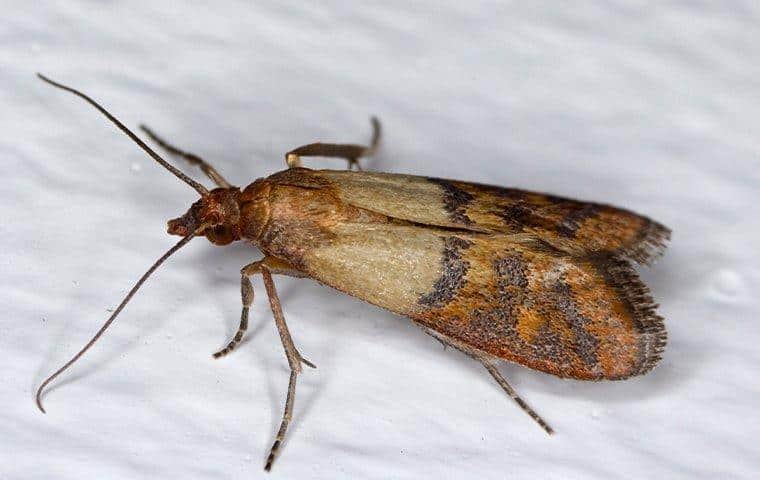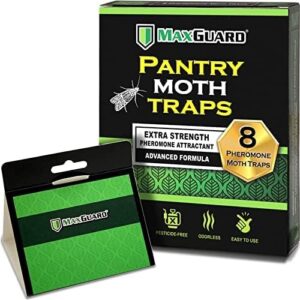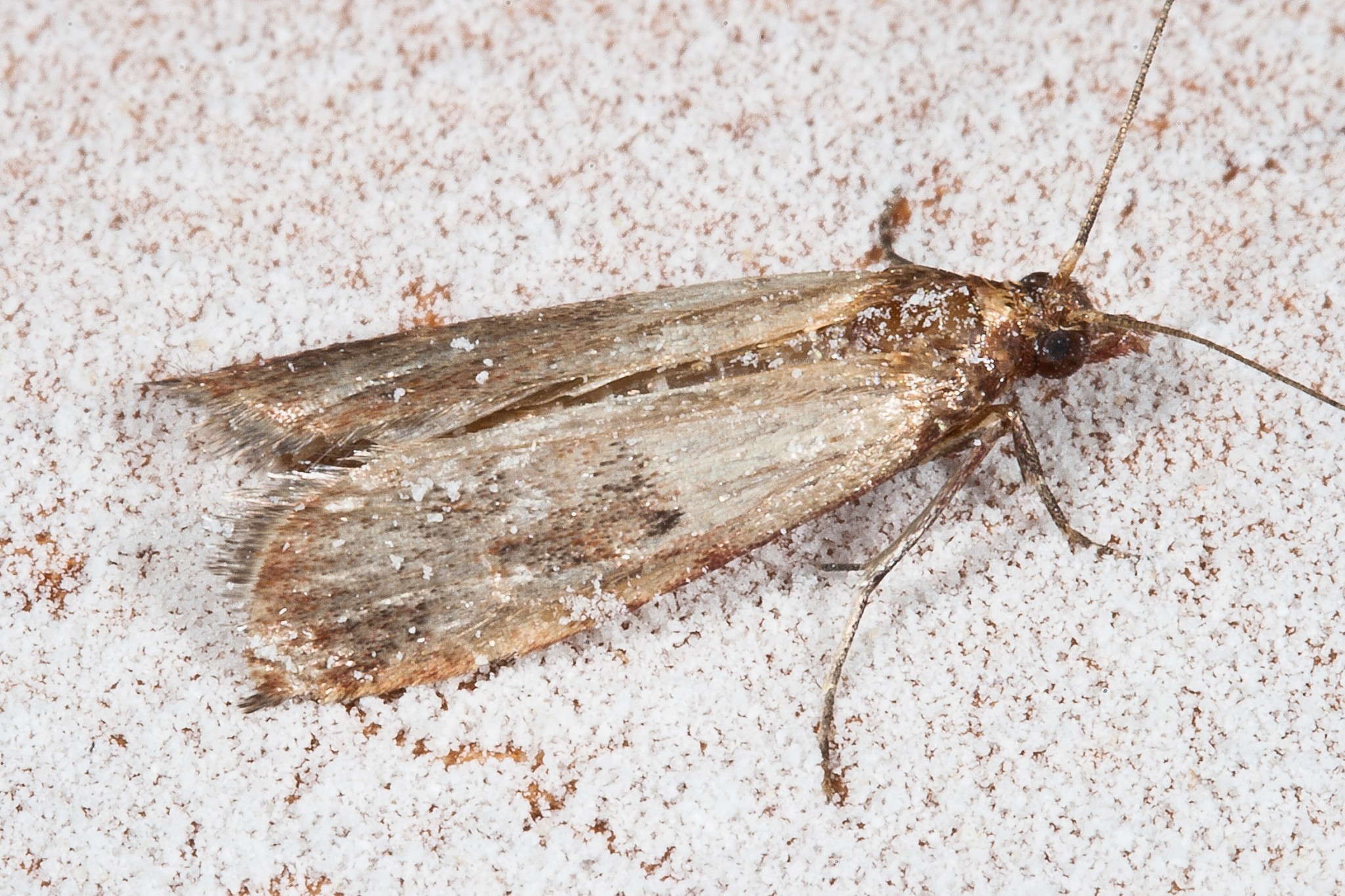Any processed or raw grain product, from dried pet food, corn kernels, and whole grains to pasta and bread in your home, is fair game to pantry moths. These pesky little invaders have a knack for turning your kitchen into their buffet.
They can find their way into every nook and cranny of your pantry, leaving a trail of destruction in their wake. Pantry moths may generally be harmless and do not bite, but that doesn’t mean you want them infiltrating your food.
Luckily, with the right approach, you can banish these unwanted guests.
How To Get Rid Of Pantry Moths Naturally
1. Examine The Problem
First, thoroughly inspect your pantry and identify the source of the problem. Clear out every time in your pantry shelves and food storage areas to get a clear view of the space. Focus on corners, crevices, and cracks where pantry moths and their larvae may hide during inspection.
Look for infestation signs like webbing, larvae and adult moths, or droppings in and around food containers. Pantry moth excrements appear as small, dark specks or pellets.
After identifying signs of moth infestation, try to pinpoint the problem’s root source. Focus on areas where you’ve observed the highest moths, larvae, or webbing concentration. Inspect nearby food items and containers to determine the origin of the infestation.
Read More:
2. Dispose of Infested Items
Once you finish the inspection, gather all food items showing evidence of pantry moth activity, including goods in open containers, and put them in a sealed plastic bag. After that, throw the bag into an outdoor trash bin, then close the bin securely. If possible, schedule a regular trash pickup to remove the infested items from your property quickly.
Next, thoroughly clean and sanitize the area surrounding your trash bins to remove any traces of food or residue that could attract pantry moths or other pests. Dispose and clean thoroughly because even seemingly infestation-free items may have eggs or larvae.
3. Clean Your Pantry
A complete clean-up of your pantry or food storage space is essential when banishing pantry moths. So, thoroughly vacuum the shelves and surfaces of your pantry, including corners, cracks, and crevices, to remove any crumbs, food particles, or debris.
After vacuuming, wash the pantry shelves and surfaces with warm, soapy water and a sponge or cloth to scrub the shelves. Next, rinse the shelves and surfaces with water to eliminate soap residue. Then, dry the shelves with a clean towel or cloth because moisture can attract pantry moths.
Your pantry shelves and surfaces could use added protection against pantry moths and other pests. Therefore, disinfect them with a vinegar solution. Wipe down the shelves with this solution using a clean cloth or sponge, then allow them to air dry completely.
4. Seal Your Food
Place your food in airtight glass, plastic, metal containers, or sealed bags. Group similar items together and label containers with the contents and date of purchase to help you keep track of inventory.
Consider transferring bulk food items, such as grains, flour, and rice, from their original packaging into airtight containers. Typically, bulk packaging lacks adequate sealing, making it vulnerable to pantry moth infestations.
Tightly seal partially used packages after use with clips, rubber bands, or twist ties to prevent pantry moths from accessing the contents. Also, consider storing vulnerable food items, such as nuts, seeds, and dried fruits, in the refrigerator or freezer.
5. Temperature Control
Pantry moths thrive in warm environments, so deter them by keeping your pantry cool. Aim to maintain a temperature between 50°F and 70°F (10°C to 21°C) to create an inhospitable environment for these pests.
Also, install vents or air ducts to promote air circulation and prevent stagnant air, and if necessary, use a small fan to improve airflow and keep your pantry cool and dry.
Moreover, maintain ideal humidity levels (below 50%) by running a humidifier. High humidity creates perfect breeding conditions for pantry moths. A hygrometer monitors humidity levels, so consider buying and placing one in your pantry’s central location.
In addition, food shelves or pantries should be positioned away from heat sources like ovens, stoves, and direct sunlight because heat attracts pantry moths.
6. Freeze or Heat Infested Items
You do not have to discard items already infested by pantry moths. Instead, consider freezing or heating them. Place infested items that can withstand freezing temperatures, such as grains, flour, nuts, and dried fruits, into a sealed plastic bag and place them in the freezer for at least four days. Low temperatures can kill the eggs, larvae, and adult moths.
As for items that can tolerate heat, such as spices, herbs, and other dry goods, put them in an oven at a temperature of at least 120°F (49°C) for 30 minutes to one hour. However, be cautious not to overheat items or cause them to burn.
7. Use Natural Repellents
There are several natural repellents you can incorporate into your pantry maintenance routine to deter pantry moths and keep them from returning. The options include:
a) Cedar Blocks or Chips
Place cedar blocks or chips in your pantry shelves or storage containers to create a protective barrier against moths. Cedarwood’s natural oils repel insects. Refresh the cedar scent periodically by sanding the blocks or adding cedar essential oil.
b) Dried Lavender
Lavender’s strong aroma is unpleasant to pantry moths, so it can keep them from infesting your house. Place dried lavender sachets or bundles in storage containers or pantry shelves. Alternatively, use a homemade moth-repellent spray with lavender essential oil.
c) Bay Leaves
The pungent smell that bay leaves produce repels insects; hence, it should keep pantry moths from lurking around or nesting. Therefore, spread dried bay leaves around your pantry and replace them periodically to maintain their potency as a repellent.
d) Cloves
Place whole cloves or clove essential oil on cotton balls in your pantry shelves or storage containers to deter moths. This substance’s strong scent helps repel pantry moths.
e) Rosemary
This plant deters pantry moths through its strong scent. Place dried rosemary sprigs or essential oil on cotton balls in your pantry or storage containers to discourage moths.
f) Eucalyptus
Mix eucalyptus oil with water and spray it on food storage containers or shelves to create a natural moth-repellent. Alternatively, hang eucalyptus branches or leaves in your pantry.
g) Lemon
Spread citrus peels or lemon essential oil on cotton balls in your kitchen, pantry, and under appliances and cabinets to keep pantry moths away. You can also spray lemon essential oil to achieve the same effect.
h) Peppermint
Peppermint oil is also effective in repelling pantry moths. Spray peppermint oil and water solutiom strategically in areas prone to pantry moths. Alternatively, use peppermint leaves or cotton balls soaked in peppermint oil.
8. Invest In Pheromone Traps
These traps lure and ensnare adult male pantry moths, disrupting their mating cycle and diminishing moth populations. They contain a sticky adhesive surface and a lure infused with female moth pheromones, which attract male moths.
Buy pheromone traps, assemble them, and place them strategically throughout your pantry. Pay attention to areas where pantry moths are most active or where you’ve observed moth activity.
Besides helping trap pantry moths, pheromone traps will help you keep tabs on their population. If the traps remain empty, you will be sure that you have eliminated these insects.
Prevention Measures
Once you’ve successfully eliminated pantry moths from your home, take preventive approaches to deter future infestations. Here are some tips to aid you:
i) Inspect Purchased Groceries
Before buying packaged food items, look for any signs of damage, including tears, holes, or openings that could allow pantry moths or their eggs to enter. Pantry moths can get into your pantry via infested items from the store.
ii) Rotate Your Food Stock
Apply the First-In, First-Out (FIFO) when arranging your groceries. Place the newly bought items behind or underneath the older ones. This will ensure you consume the older foods before they expire, thus reducing the risk of pantry moth infestations in forgotten items.
Also, rotate food items per their expiration dates. This helps you identify the items you must use soon and prevent them from sitting in your pantry too long.
iii) Keep Your Pantry and Kitchen Clean
Thoroughly clean your pantry and kitchen weekly. This includes wiping down shelves, countertops, and other surfaces, as well as sweeping or vacuuming the floors and emptying garbage bins.
Furthermore, clean up spills promptly and wipe surfaces clean. In addition, organize your pantry properly to ensure you can easily find items and prevent clutter.
iv) Monitor Your Pantry
Early detection will keep a small infestation from escalating. Therefore, regularly inspect your pantry for signs of pantry moth activity, such as larvae, webbing, or adult moths flying around.
v) Seal Entry Points
Seal any gaps in your walls, ceilings, floors, utility openings, windows, vents, and doors that could facilitate the entry of pantry moths to your house.
Final Remarks
Sophisticated methods are not necessary to eliminate pantry moths. A thorough examination and clean up of your pantry, discarding infested items, temperature control, and properly storing your food are vital to keeping pantry moths at bay. However, should the infestation persist, seek an expert’s help.

I’m Mike Hyle, an exterminator with 7+ years of experience handling all sorts of pests, including mice, cockroaches, bed bugs, and termites. I also write for Pest Solutions DIY blog to share my knowledge and help homeowners keep their homes pest-free. Outside work, I enjoy hunting, snowshoeing, and exploring nature. Check out my blog for helpful pest control tips!





